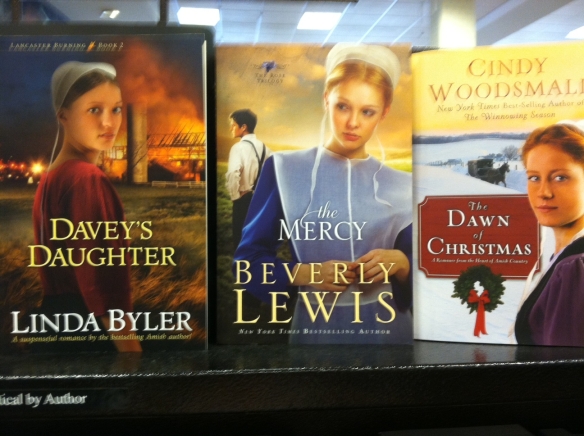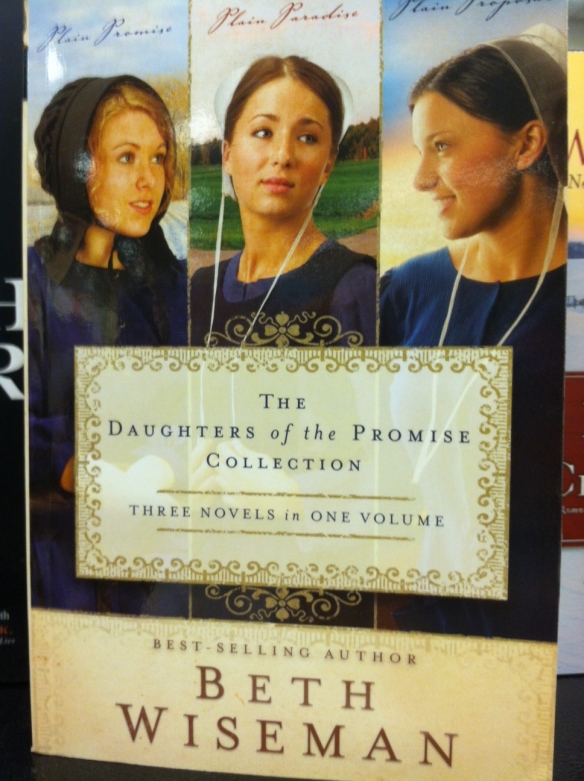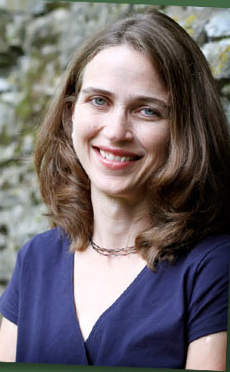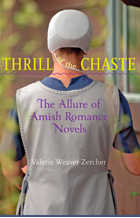Browse the inspirational-fiction section of most bookstores, and you will find cover after cover of comely young women wearing dresses with capes, and often pensive expressions . . . . Occasionally a male figure lingers in the background, his face obscured by a hat, but more often the Amish maiden is alone in her pastoral reverie, gaze averted and thoughts inscrutable.

Photo at Barnes & Noble Bookstore featuring authors Beverly Lewis, Cindy Woodsmall, and Linda Byler, the only Amish novel writer who is herself a member of the Old Order Amish
So begins Valerie Weaver-Zercher’s Thrill of the Chaste: The Allure of Amish Romance Novels, published by Johns Hopkins University Press, an in-depth analysis of the appeal of Amish fiction. She looks closely at writers, readers, and the cultural changes at the heart of this phenomenon. And a phenomenon it truly is: 95 new Amish romance novels were published in 2012, at “the rate of about one every four days.” (4)
I met Valerie at a lecture she presented at Eastern Mennonite University in October 2013. She noted that some view Amish romance novels as fluff, nostalgic but formulaic concoctions. But novelists like Beverly Lewis, Linda Byler, Wanda Brunstetter, and Cindy Woodsmall must have tapped into the deep yearnings of many readers. Why else would their books fly off the shelves of bookstores?
“Are you curious too?”
“Okay, I thought so.”
Since her lecture, I have communicated with Valerie to bring you the essence of her lecture in a crisp Q & A format.
MLB: Why is Amish romance fiction so popular?
VWZ: As I talked to readers of Amish fiction, I heard lots of things about why they like Amish novels. But they mentioned two reasons over and over again. First, for loyal readers of the genre, the books offer a vacation, of sorts, to a “slow and simple life.” Many people articulate their love of Amish fiction as inversely related to the spiraling nature of modern life: that is, as contemporary life feels more and more sped up, chaotic, and complex, they are more drawn to narratives of a people who have apparently escaped the craziness. While the readers with whom I spoke didn’t use this term, they were expressing a thought similar to an idea French theorist Gilles Lipovetsky introduced in 2005: hypermodernity. He defined hypermodernity as “the frenzied escalation of ‘more, always more’ [that] has now infiltrated every sphere of collective life.” This hypermodern context is characterized by the high speed of technological change, information transfer, consumption, social change, individualism, global capitalism. Many of us experience it simply as the feeling that life is moving at a pace that we simply can’t keep up with. So Amish fiction, in an age of hypermodernity, offers readers the means through which to take a temporary vacation.
Second, readers said they like Amish novels because they are “clean reads”: that is, books devoid of the sexualized content that permeates much of popular culture products. Sociologist Kenneth Kammeyer employs the term hypersexual to describe a situation in which “sexual discourse, erotica, and pornography are present in almost all aspects of society.” Other observers have used terms like pornified, raunch, and striptease to characterize twenty-first-century culture, evidenced by thongs and push-up bras marketed to elementary-school-aged girls. So readers, many of whom are evangelical Christian women, find in Amish novels a respite from the feeling of being bombarded by hypersexualized culture.
But there are other reasons too. Some of the reasons have to do with the fact that publishers can get more books into the hands of more readers more quickly than ever. So the fact that there are more Amish novels being published likely means that more readers are finding them. That is, there’s a greater demand for Amish novels than ever; there’s also a greater supply.
MLB: What are these novel readers seeking?
VWZ: As I said above, I think there’s a great appeal for many readers in the feeling of a temporary, imaginative vacation from hypermodern, hypersexualized life. The novels allow readers to vicariously participate in an Amish life without actually having to give up their Kindles and their life insurance and their cars. The more technologically saturated our lives become, the more intrigued we are, I think, by people who have escaped at least some of it.
MLB: Do these stories reflect real Amish life?
VWZ: That’s a complex question, actually, and one that is difficult to answer. I have a whole chapter in my book about that question. Some of it depends whether you’re talking about the genre as a whole or about the work of a particular novelist and whether you’re talking about the tangible details of Amish life, or the more intangible cultural and religious sensibilities of the Amish. Also, there are so many different ways of being Amish these days that if readers think that reading a novel set in one community—even a quite accurate novel—makes them knowledgeable about the Amish: well, they’re probably wrong.
Overall, I would say that most readers likely learn more that is correct about the Amish than information that is incorrect. Having said that, there are lots of misperceptions about Amish life that circulate in the novels and get passed on to readers, especially related to shunning and rumspringa. And then there’s the larger question of whether we as outsiders can understand Amish life from the inside-out well enough to craft a narrative that accurate reflects the internal life, spirituality, understanding of the church and family, etc., of an Amish person. That is, a novel might get all the “facts” of Amish life right, but still miss the more abstract, intangible feel of looking at the world from an Amish perspective. So that’s not a very good answer; but those are some of the reasons that the question is a hard one!
MLB: Obviously you read some of these novels during the course of writing your book. Did you enjoy reading them?
VWZ: I enjoyed some of the novels and disliked others. I actually don’t read a ton of fiction in general; I tend to read more nonfiction. I’m now working as a book editor for the Mennonite publisher, Herald Press, and I have really enjoyed editing a historical Amish novel entitled Jacob’s Choice by Ervin R. Stutzman. It comes out in February 2014. It’s based on actual events in the mid-1700s: an attack on the Amish Hochstetler family during the French and Indian War. I’m a descendant of the Hochstetler family, as are many Swiss-German Mennonites and Amish in Pennsylvania and other states, so I and many other readers have a special interest in reading this novel. It’s the first of three in the Return to Northkill series.
MLB: In general, readers of inspirational fiction are evangelical Christian women. Who else is included in the demographic of Amish romance novel readers?
VWZ: I talked to men who love Amish fiction, Catholic women who love it, and African Americans who read it. And as I did my research, I kept hearing about more and more people who don’t fit the evangelical female demographic. Old Colony Mennonites (both men and women) in Bolivia, for example. Old Order Mennonite readers. Amish readers. A missionary doctor. A librarian. An at-home mom. The readership is diverse, even as evangelical Christian women still constitute the bulk of the audience.
MLB: How do Amish readers themselves respond to these novels?
VWZ: I have a whole chapter on that question too! I also reflect on that question in this piece in the Los Angeles Review of Books. The Amish people I interviewed had opinions all over the map. Most were at least semi-critical of the novels, especially the fact that most are being produced by outsiders.
MLB: Your book, which you dub “narrative scholarship,” is a marvel of research with a 9-page bibliography, which includes books, magazine articles and interviews. Though well-documented, the book is witty and often reads like a story. How much time did this project require?
VWZ: Yes, I spent a lot of time on the research and writing of this book. I researched and wrote over the course of about a year, and then spent about six months working on revisions of various kinds. But I loved the entire process, despite moments of being unconvinced that I’d be able to pull it off. The variety of things I got to do—talk to readers, visit a book group, chat with Amish folks, read novels, read theory, and of course write—was just lovely. It was indeed very hard work, but very fulfilling. I loved the challenge of blending a narrative nonfiction voice with an analytical/scholarly lens.
MLB: You are busy mother of three young boys and an author husband. How did you manage to write this book along with your family obligations?
VWZ: It wasn’t easy. But I was freelancing at the time, so I was able to decline editing projects or just take on the ones I had time for and then devote the rest of my time to research and writing. Our kids are all in school now, so I wrote during the day while they were at school and sometimes early in the morning or occasionally (very occasionally!) late at night. I do much better getting up early to work rather than trying to stay up late. Also, I got a fellowship from the Young Center for Anabaptist and Pietist Studies at Elizabethtown College during the fall of the year I was working on this book, and that helped me to prioritize the project and begin to wrap up the writing.
About Valerie Weaver-Zercher
Valerie Weaver-Zercher is author of Thrill of the Chaste: The Allure of Amish Romance Novels. Her writing has appeared in the Wall Street Journal, Chicago Tribune, Los Angeles Times, The Christian Century, Sojourners, and The Mennonite, among other publications. She is also managing editor of trade books at Herald Press. She and her husband Dave have three sons and live in Mechanicsburg, Pennsylvania. They attend Slate Hill Mennonite Church.
Enter to win a copy of her book by entering the book giveaway contest!
If you would like to enter for a chance to win a copy of Thrill of the Chaste: The Allure of Amish Romance Novels by Valerie Weaver-Zercher, simply leave a comment at the bottom of this post. Valerie has graciously offered to donate a copy of her book to the winner!
If you are reading this anywhere other than my blog, such as on Facebook or in an email please hop on over to my blog, Plain and Fancy Girl. Only comments left on my blog will be entered into the giveaway.
The deadline for this contest is Saturday, November 9, 2013, at noon. The winner will be chosen using Random.org and will be contacted privately via email as well as cited in an announcement in a blog post here next week.
Now it’s your turn!
Make a comment or ask Valerie a question about Amish romance novels or about her other writing.




I saw where Carolyn won a book and thought I would take a turn! I have seen tv stories about the Amish and the movie, The Witness staring Kelly McGillis. It is truly delightful to read or see something wholesome and without offensive language! I will be waiting for your book, Marian! Judy
Right! You\’ve thrown your hat into the ring, and you have as good a chance as anyone to win Valerie\’s book. Are you a fan of Amish romance novels? This is a thorough introduction to the genre, actually sub-genre.
Marian, fascinating interview and obviously a well-research book has been written by Valerie. I have a long running fascination with the Mennonites, Amish and others of a similar cultural heritage. And I have read several of the authors Valerie mentioned. Thanks so much for taking the time to interview Valerie.
Valerie, thank you for joining Marian today for this insightful interview. I\’m keeping my fingers crossed that I\’m the lucky winner today!
You have a good chance of winning that book too, you the book reviewer extraordinaire! Valerie is quite a scholar as you can see from her well-researched text and her glowing resume.
I am fascinated with research. It was my favorite assignment while working in a law firm — research this or that. I\’m looking forward to that aspect of the two historical novels I hope to write after finishing my memoir. I\’ll be keeping my fingers crossed for luck!
Reblogged this on Found Between the Covers and commented:
Fascinating interview with writer Valerie Weaver-Zercher about her book, The Thrill of the Chaste: The Allure of Amish Romance Novels.
Thanks for the re-blog, Sherrey! I am honored, and I\’m sure Valerie is too.
Definitely worthy of a reblog!
This really sounds like a great book. I would love to win a copy of this book!!
You are entered into the contest, Elaine. You may indeed be the randomly drawn name! Do you read Amish romance novels? Other fiction? We\’d like to know.
I would like to win a copy of the book,can you please leave me a message through FB,the name is under Deborah Hoffman…….P.S. my last name was changed in July,you know what that is………Thanks!……P.S.2……I have a 2nd cousin that had a Daughter,now deceased,and her cousins were Amish……I never met her,she died in 2006,age 29.
You are entered into the contest, Deborah. If you win in our random drawing, I would know how to contact you for sure!
I especially enjoy hearing how Valerie was supported to write her book, and I would love to read a book that is a combination of fun and scholarly insights.
Dolores, Valerie dubs her book \”narrative scholarship\” and in my view lives up to its name. Maureen Freely once said of a critical analysis of Willa Cather\’s work by Hermione Lee that it is a \”rare thing, a scholarly study that reads well.\” Valerie has indeed accomplished that rare thing in her book.
Hi Marian,its Debbie,I was wondering where Valerie lives,just give me a general idea,is she from lancaster County?………my Greatgrandfathers youngest sister married a man with the last name of Weaver,she died in August 2007,5 weeks before she would have been 100 years old…….I used to go visit her sometimes,I forget how I got to know her,I know she had a few kids,and had alot of people under her,I will have to look in my relative book,we have the reunions at Landis Homes every 5 years,now I think it is every 3 years,I might have missed the last one,the last time that I went was with my great-aunt,Helen(R) G………but she died in March of 2010,at age 82.Thanks,debbie
Debbie, Valerie lives with her husband and three sons near Mechanicsburg, PA. and attend Slate Hill Mennonite Church, all information included in Valerie\’s profile on this blog post.
Enjoyed your interview with Valerie. I have never read an Ammish/Mennonite romance novel, but will definitely add it to my \’must read\’ list.
Thanks for dropping by again, Carolyn. You have been entered into this contest too. Happy reading!
Just as \”white middle-class Americans have been assimilated into mainstream culture largely by losing specific ethnic identities,\” (p. 216) so Christianity has been diffused into acceptable \”gospel\” (p. 59) for today\’s society. Is it possible that Amish novels are popular because within at least some of the books, people are actually living out God\’s principles? Could it be possible that God is using certain Amish stories to bring people to see their lives as utterly meaningless without Jesus, and the enabling power of His Spirit, which is the only gospel worth spreading?
Thanks for this opportunity to win Thrill of the Chaste.
It is obvious you have an intimate knowledge of Valerie\’s book with her specific reference to Susan Trollinger\’s research. And you ask probing questions as well. I would like to think one answer to both questions is \”Yes, it is possible. . . .\”
Thank you for stopping by–and welcome! And yes, you are certainly entered into the contest.
I look forward to reading this book. There\’s a large Inspirational Fiction section at the library where I work, and while I\’ve shelved hundreds of these books, I have to confess I haven\’t actually READ one yet. Maybe the insights in The Thrill of the Chaste will help me appreciate the Inspirational section and get motivated to read some of it.
Welcome to the comment corner, Rebecca. I have a feeling you\’ll be paying more attention to the inspirational fiction section of your library — maybe even check on frequency of check-outs, if you have access to such data. Again, thanks for dropping by!
Very insightful. Who knows maybe I\’ll even put down my novels I listen to on CDs and pick up an actual Amish book. That would be new for me.
You are entered in the contest regardless. Now your hat is in the ring. Who knows what the luck of the draw will be!
These drawings that you offer are fun and a great way to involve your readers. I enjoyed the interview!
Thanks for always being so encouraging, Traci. I regard you as a \”gentle mentor.\” Say it out loud and it rhymes, sort of!
I would love to read your book, and hope I win it!
Though I read everything, I prefer not to read sexually-explicit scenes.
The novels I write are for the pre-teen reader. My mysteries are set on Mayne Island.
I haven’t read any Amish books yet, but will definitely look into the genre.
Amber, I just checked your website to get a sense of your writing. I know some little people that I think would love your books. Mysteries set in British Columbia sound very appealing. As to the sub-genre of Amish romance novels, there are some titles and authors in this post to get you started. Thanks so much for stopping by to comment!
I enjoyed Valerie\’s presentation on her research for her book at my 50 year college reunion at EMU and look forward to reading it. I think it will give me answers as to why the Amish novels attract so many readers. I hesitate adding them to the collection in my church library, but perhaps there is value to giving thought to the reasons for their allure.
Many share your ambivalent feelings about Amish romance novels. Are they just fluff or are they valid choices for a serious reader? One answer is this: \”It all depends . . . .\” Valerie definitely weighs the pros and cons of this sub-genre and evaluates many titles and authors she herself has read.
Hi, all. Thanks for your kind words and comments! I wish I could reply to each one. As Marian knows and as I mention in my post, I just started a new job and am trying to keep my head above water. And with three boys whose lives keep me hopping, time feels short. But know that I appreciate all the feedback and interest in my book; and thanks, Marian, for hosting this discussion! I\’m very honored.
As you can tell, Valerie, there are a host of people wishing to win a copy of your book! Yes, all of us feel a time crunch, and we understand your particular dilemma, especially with three energetic boys.
This blog post was fascinating to me, as is The Thrill of the Chaste, book. I wrote a novel about a teenage boy going to spend a summer on his grandfathers\’s Amish farm, Under the Heavens. This project was a result of friendships with Amish neighbors, because of our shared interest in horses. I had so many good experiences I wanted to share them with those who may enjoy learning about daily life on an Amish farm. I feel as though I stumbled into a field where I am the odd man out, (much the same way my non-Amish, main character, feels on his Amish relative\’s farm). \”Under the Heavens\” is not a romance novel, though is does have something of a romance in it. It\’s a great thing if readers pick up my book because of this fascination with Amish romance novels, yet, I fear that others will pass it by who aren\’t interested in \”those books.\” I would be interested to hear, if while you were researching this topic, you found many novels that are about the Amish but not in the romance vein? I will end up reading \”The Thrill of the Chaste\” for sure.
Welcome to my website, Thomas. – I have just browsed your website and notice that you are a horseman as well as a writer with a daughter who helps promote your books, a great combination.
I do have a title for you. It\’s Amish fiction, but not necessarily romance fiction. Jacob\’s Choice by Ervin R. Stutzman – I have not read this book, but the author and title suggest a more masculine point of view: http://www.amazon.com/Jacobs-Choice-Return-Northkill-Book/dp/0836196813/ref=sr_1_1?s=books&ie=UTF8&qid=1400437251&sr=1-1&keywords=Jacob%27s+Choice
In fact, the website referenced above is the first in a series, so if you like this author, there is more than one to enjoy. As far as I can tell, it is based on historical facts with a fictional narrative.
Another post you may enjoy on my website: http://plainandfancygirl.com/2014/03/29/amish-buggies-they-come-in-colors/
Thanks for stopping by and commenting. I hope you will visit again and add your bit of wisdom.
Marian, your post today (July 20 2016) about Louisa Adam\’s life led me circuitously to Goodreads and then to your review/interview with my now colleague, Valerie Weaver-Zercher about her book Thrill of the Chaste. At first I thought we must have been in the same room because I attended a workshop in 2012 with Valerie at EMU, Mennonites & Writing IV (I believe it was before her book was actually published). So you must have heard her at homecoming at EMU. Eh? Well, a near miss I guess.
I was at EMU in 2013 for my 50-year reunion where Valerie was again featured and promoting/selling her book. It was a \”miss\” by one year. I have a feeling I will meet you face to face sometime. Eh?
Sooner or later!! Looking forward to it.
🙂